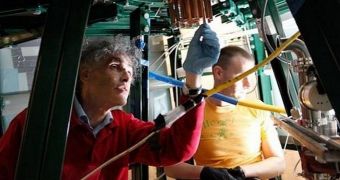Fossil fuels are drying up, solar-capturing technology isn't advancing quickly enough and batteries just aren't cutting it. Fusion power was seen as even more remote than geothermal and effective solar power harnessing, but this might no longer be the case.
In fact, you can contribute a few dollars and be among the ones responsible for the enabling of commercial fusion power by the end of this decade.
You see, a crowd-funding campaign has appeared on Indiegogo, set up by a group of researchers from LPP Fusion, based in New Jersey.
The campaign says that it only needs to reach its funding goal of $200,000 / €145,000 in order to start making fusion reactors by 2020.
Fusion reactors which will each cost $500,000 / €290,000, curiously enough, much less than nuclear reactors.
The fusion reactors would also be a lot smaller, capable of fitting inside a garage or shipping container while producing 5 MW (megawatts) for 0.06 cents per kWh.
Thus, a relatively small reactor would have enough energy for 3,500 homes, while needing customers to pay a twentieth of the current price.
All in all, the project sounds like a miracle compared to the ITER project being built in the south of France for $13.7 billion / €10 billion. All owing to the different approach.
In theory, crowd-funding wouldn't even be needed to finance the project put forward by LPP Fusion, but the chief scientists said that most financial resources have been eaten by ITER.
So what's the difference? Focus Fusion doesn't fight the instabilities that result when you try to capture plasma in nuclear fusion. Making the plasma stable is the biggest and most costly challenge of ITER, and LLP Fusion say they don't treat that as a problem, but as a resource to be harnessed.
The main device, only a few inches-wide, has a hollow cylinder at the center, made of copper. This anode is insulated (in white) from the circle of copper rods acting as an outer electrode (cathode). A vacuum chamber filled with the fusion fuel holds this arrangement.
The chamber, in turn, is connected to a capacitor bank that pulses over a million amps from the cathode to the anode in a single microsecond. That ionizes the gas, turning it into plasma. And with parallel currents running through that plasma, a magnetic field is generated, forcing dense plasma filaments to twist around each other, keeping all the plasma concentrated in a small area.
Meanwhile, the magnetic fields shape the plasma filaments into a plasmoid shaped like a donut, compressed to less than a few mm across. When a certain density is reached, radiation starts to escape from the plasmoid center.
That causes the magnetic field to fail, hurling a beam of electrons on one end and a beam of ions from the other. The interaction between the beam electrons and the ones in the plasmoid heat the area to over 1.8 billion degrees Celsius, which makes fusion reactions possible.
That lets boron and hydrogen atoms briefly fuse into a carbon nucleus, and subsequently break into three helium atoms and a lot of energy. This reaction doesn't leave radioactive waste (unlike the normal approach that uses deuterium and tritium) and the end products don't last for more than 20 minutes, ensuring that it only takes nine hours for the radiation in the reactor to settle down to normal level in nine hours or so.
Finally, the end product of the reaction consists of charged particles, capable of being directly turned into electrical power, making the whole process 10 times cheaper and more efficient. At the end of it all, electricity is gathered from the ion beam (60%, captured and converted by a magnetically-fluctuating metal coil) and the x-ray pulse caused by the reaction (40 percent).
The Indiegogo campaign is there only because the researchers need money to buy some beryllium electrodes. They intend to prove their approach and build a prototype by 2016.

 14 DAY TRIAL //
14 DAY TRIAL //